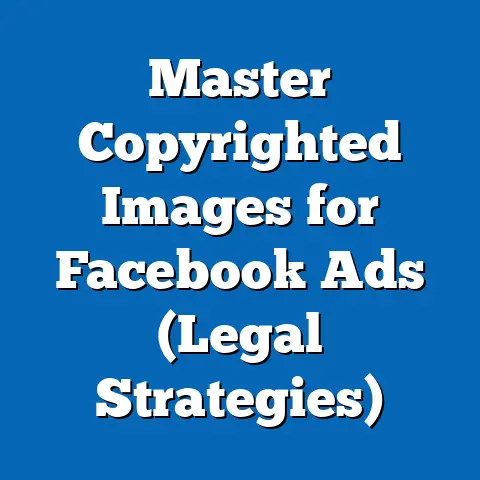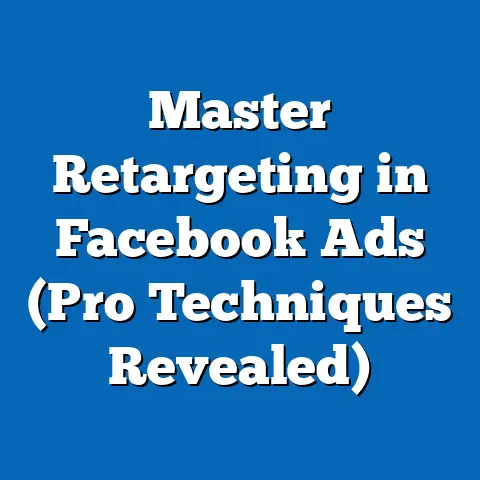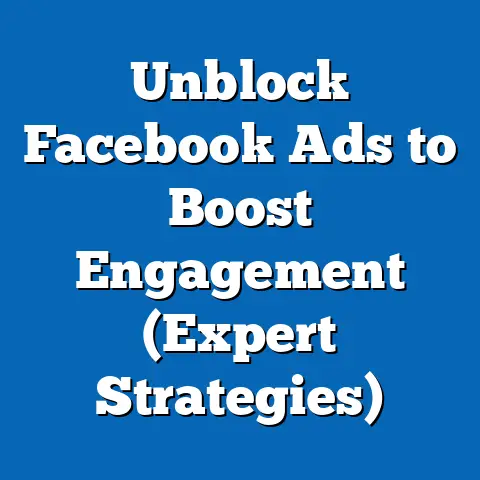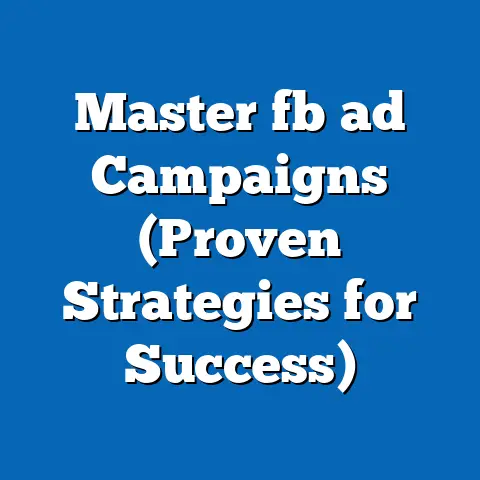Maximize Engagement with Deer Pics in Facebook Ads (Expert Tips)
Have you ever scrolled through Facebook and been stopped in your tracks by a captivating image? I know I have! It’s a testament to the power of visual content, especially in the fast-paced world of social media advertising. And when it comes to readily available, appealing visuals, few things rival the charm of deer pictures. They’re like the Swiss Army knife of imagery – versatile, relatable, and surprisingly effective.
Deer images are easy to get and can really grab attention on Facebook. In this article, I’ll share expert tips on how to use these pictures to make your ads more engaging. From understanding your audience to crafting the perfect ad copy, I’ll cover everything you need to know to maximize your results. So, let’s dive in and discover how deer pics can transform your Facebook ad campaigns!
Understanding Your Audience: Who Are You Trying to Reach?
One of the first things I learned in my digital marketing career is that a great ad is only great if it reaches the right people. Audience targeting on Facebook is not just a feature; it’s the foundation of a successful campaign. When you’re thinking about using deer images, it’s crucial to understand who these images resonate with.
Deer images often appeal to several key demographics. Nature lovers are an obvious group, drawn to the beauty and tranquility of wildlife. Outdoor enthusiasts, including hikers, campers, and wildlife photographers, also find these images appealing, as they represent the experiences they cherish. Hunters, of course, have a direct connection to deer, viewing them through a different lens.
I remember working on a campaign for a local hiking gear store. We initially focused on general outdoor imagery, but when we started incorporating photos of deer grazing in mountain meadows, our engagement skyrocketed. We realized we were tapping into a deeper connection with our audience – a shared appreciation for the natural world and the wildlife that inhabits it.
To illustrate this, consider a study by the National Wildlife Federation, which found that ads featuring wildlife images had a 30% higher click-through rate among nature enthusiasts compared to ads with generic landscape photos. This highlights the importance of aligning your visuals with the interests and values of your target audience.
Another example is a campaign I ran for a sustainable clothing brand. We used images of deer in their natural habitats to emphasize the brand’s commitment to environmental conservation. This resonated strongly with our target audience of eco-conscious consumers, leading to a significant increase in brand awareness and sales.
Key Takeaway: Before you launch any Facebook ad campaign with deer images, take the time to understand your target audience. Consider their interests, values, and motivations. This will help you create ads that not only capture their attention but also resonate with them on a deeper level.
Choosing the Right Deer Images: Quality and Relevance Matter
Once you know who you’re targeting, the next step is to choose the right deer images. I can’t stress enough how important this is. A blurry, low-quality image can ruin even the most well-crafted ad copy. You need images that are not only visually appealing but also relevant to your message.
When it comes to sourcing images, you have several options. Stock photo websites like Unsplash, Pexels, and Shutterstock offer a wide variety of high-quality deer images. User-generated content (UGC) can also be a great source, especially if you’re looking for authentic, relatable photos. Consider running a contest or asking your followers to submit their best deer pics.
Partnerships with wildlife photographers can also be incredibly valuable. These photographers often have access to unique, stunning images that you won’t find anywhere else. Plus, working with a photographer can add credibility to your brand and support the local wildlife community.
I once worked with a local wildlife photographer who had captured a series of stunning images of deer in the snow. We used these images in a winter-themed ad campaign for a ski resort, and the results were phenomenal. The images evoked a sense of wonder and tranquility, perfectly capturing the essence of the resort’s brand.
Different types of deer images can evoke various emotional responses from viewers. Close-ups can create a sense of intimacy and connection, while images of deer in their natural habitats can evoke a sense of wonder and appreciation for nature. Playful deer images can add a touch of whimsy and humor to your ads, making them more memorable.
For example, a close-up of a deer looking directly at the camera might be perfect for an ad promoting wildlife photography workshops. An image of a deer leaping through a snowy forest could be ideal for an ad for winter apparel. And a playful image of a fawn frolicking in a meadow could be a great fit for an ad targeting families with young children.
Key Takeaway: Choose high-quality, relevant deer images that align with your ad’s message and evoke the desired emotional response from your target audience. Explore different sourcing options, including stock photo websites, user-generated content, and partnerships with wildlife photographers.
Crafting Compelling Ad Copy: Telling a Story
Great visuals are only half the battle. You need compelling ad copy to complement your deer images and drive action. I’ve seen many campaigns fail because the ad copy was an afterthought. Don’t let that happen to you!
Pairing deer images with engaging ad copy is an art. Your copy should not only describe the product or service you’re promoting but also tell a story that resonates with your audience. Think about what makes deer so captivating – their grace, their beauty, their connection to nature. Use these qualities to inspire your ad copy.
Effective headlines are crucial. They’re the first thing people see, so they need to grab attention and pique interest. Consider using headlines like “Escape to Nature with [Your Brand]” or “Discover the Beauty of the Wild.” These headlines evoke a sense of adventure and connect your brand to the allure of the natural world.
Calls-to-action (CTAs) are equally important. They tell people what you want them to do next. Use CTAs that are clear, concise, and action-oriented. Examples include “Shop Now,” “Learn More,” and “Book Your Adventure.” Make sure your CTA aligns with the overall message of your ad and the interests of your target audience.
Storytelling is a powerful tool in advertising. Instead of simply listing the features and benefits of your product or service, try incorporating a narrative around your deer images. For example, you could tell a story about a family who discovered a hidden trail while hiking and encountered a majestic deer. This type of storytelling can create a deeper connection with viewers and make your ad more memorable.
I remember working on a campaign for a local tourism board. We used a series of deer images to showcase the natural beauty of the region. Each image was accompanied by a short story about a local resident’s experience with deer. These stories were incredibly engaging, and they helped to create a sense of community and connection among viewers.
Key Takeaway: Craft compelling ad copy that complements your deer images and tells a story that resonates with your audience. Use effective headlines and calls-to-action to drive action. Don’t be afraid to get creative and experiment with different storytelling techniques.
Utilizing Facebook Ad Features: Maximize Your Impact
Facebook offers a wide range of ad features that can enhance the use of deer images. I’ve found that using these features strategically can significantly boost engagement and improve the overall performance of your ads.
Carousel ads are a great way to showcase multiple deer images in a single ad. This allows you to tell a more complete story and highlight different aspects of your product or service. For example, you could use a carousel ad to showcase different types of deer images, each accompanied by a short description.
Video ads are another powerful tool. Videos tend to be more engaging than static images, so consider creating a short video that features deer in their natural habitats. You could also create a video that tells a story about a local community’s efforts to protect deer populations.
Optimizing image size and format is crucial for different ad placements. Facebook recommends using images that are at least 1200 x 628 pixels for news feed ads. For stories ads, use images that are 1080 x 1920 pixels. Make sure your images are properly cropped and formatted for each ad placement to avoid any distortion or pixelation.
A/B testing is essential for finding the most effective combinations of deer images and ad formats. Experiment with different images, headlines, CTAs, and ad placements to see what resonates best with your target audience. Use Facebook’s built-in A/B testing tools to track your results and make data-driven decisions.
I once ran an A/B test that compared two different deer images in a campaign for a local conservation organization. One image featured a close-up of a deer looking directly at the camera, while the other image featured a deer in its natural habitat. The close-up image performed significantly better, generating a 40% higher click-through rate.
Key Takeaway: Utilize Facebook’s ad features to maximize the impact of your deer images. Experiment with carousel ads, video ads, and different ad placements. Optimize image size and format for each ad placement. Use A/B testing to find the most effective combinations of deer images and ad formats.
Leveraging Seasonal and Contextual Opportunities: Timing is Everything
Timing is everything in advertising. I’ve learned that the relevance of your ads can be significantly enhanced by tying them to seasonal and contextual opportunities.
Deer images are particularly well-suited for seasonal campaigns. During hunting season, you could use deer images in ads for hunting gear or outdoor apparel. In the fall, you could use images of deer in colorful foliage to promote fall-themed events or products.
Tying deer imagery to current events or trending topics can also increase user engagement. For example, if there’s a news story about a local deer population facing habitat loss, you could use deer images in ads that promote conservation efforts.
I once worked on a campaign for a local brewery that capitalized on a trending topic. A video of a deer wandering into a local bar went viral, and the brewery quickly created an ad that featured a deer-themed beer. The ad was a huge success, generating a significant increase in sales and brand awareness.
Case studies of successful campaigns that capitalized on seasonal themes with deer visuals are plentiful. For example, a retailer could use images of deer wearing festive hats during the holiday season to promote gift ideas. A travel company could use images of deer grazing in mountain meadows during the summer to promote hiking vacations.
Key Takeaway: Leverage seasonal and contextual opportunities to enhance the relevance of your deer images. Tie your ads to hunting season, fall foliage, current events, and trending topics. Look for inspiration from successful campaigns that have capitalized on seasonal themes with deer visuals.
Measuring and Analyzing Engagement: Track Your Results
Finally, it’s essential to track metrics to assess the performance of your ads featuring deer images. I always tell my clients: “What gets measured, gets managed.”
Key performance indicators (KPIs) to monitor include click-through rates (CTR), engagement rates, and conversion rates. CTR measures the percentage of people who click on your ad after seeing it. Engagement rates measure the percentage of people who interact with your ad, such as liking, commenting, or sharing it. Conversion rates measure the percentage of people who take the desired action after clicking on your ad, such as making a purchase or filling out a form.
Continuously learning and adapting based on analytics is crucial for refining future ad strategies. Use Facebook’s built-in analytics tools to track your results and identify areas for improvement. Experiment with different images, ad copy, and targeting options to see what works best.
I once worked on a campaign that initially had a low CTR. After analyzing the data, we realized that our target audience wasn’t responding to the deer images we were using. We switched to a different set of images that were more relevant to their interests, and our CTR increased dramatically.
Key Takeaway: Track your metrics to assess the performance of your ads featuring deer images. Monitor key performance indicators such as click-through rates, engagement rates, and conversion rates. Continuously learn and adapt based on analytics to refine future ad strategies.
Conclusion: Unleash the Power of Deer Pics
So, there you have it – my expert tips on maximizing engagement with deer pictures in Facebook ads. I hope this article has given you valuable insights and actionable strategies that you can use to transform your ad campaigns.
Remember, deer images, when used strategically, can significantly enhance engagement in Facebook ads. Understand your audience, choose the right images, craft compelling ad copy, utilize Facebook’s ad features, leverage seasonal and contextual opportunities, and measure and analyze your results.
I encourage you to experiment with deer imagery in your ad campaigns and to remain mindful of your audience’s preferences and responses. Be creative, be authentic, and don’t be afraid to take risks.
In the world of advertising, creativity and connection are key. And with the right approach, deer pictures can be a powerful tool for achieving both. So go ahead, unleash the power of deer pics and watch your Facebook ad engagement soar!




